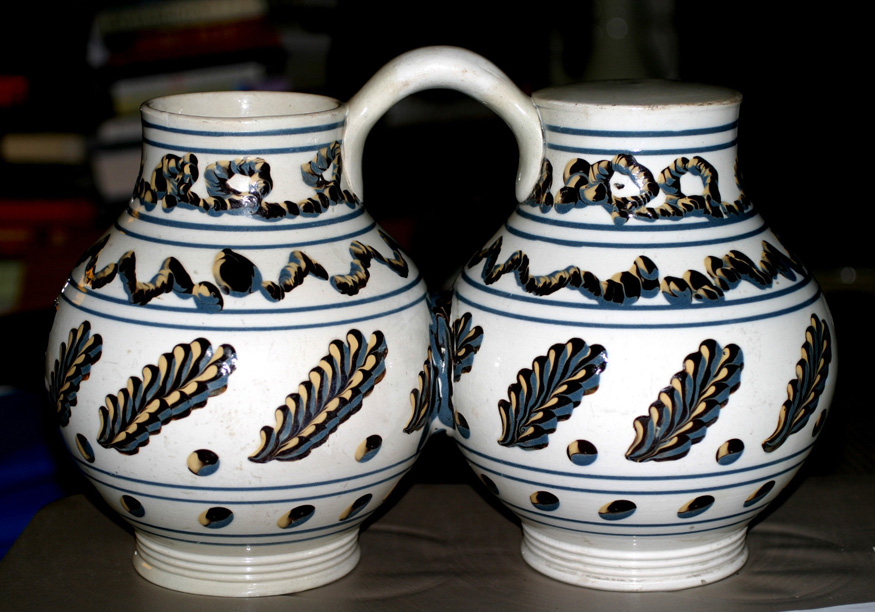Jonathan Rickard is 73 and has been collecting and researching the slip-decorated earthenware, known today as mocha, for 44 years. Graduating from the Massachusetts College of Art and Design in 1965, he went on to a successful career as a graphic designer/creative director in the advertising world. Briefly married, and with no children, he is able to devote his time and energy to his passions — mostly mocha. He wrote the definitive book on the subject, Mocha and Related Dipped Wares: 1770–1939.
What got you interested in mocha and how did the collection develop?
In the late 1960s, I went to a Skinner auction and saw several pieces of mocha. I’d never seen any before. I was hooked, but I didn’t buy any at that sale. I wanted to learn about it first, but there was almost nothing published. A few years later, in 1972, on a trip to England I bought my first piece. We were at a flea market and a dealer was drinking coffee from a mocha mug. I offered him 5 pounds for it. He promptly emptied the coffee and handed me the mug. I later learned that it wasn’t a great piece but on that trip I bought enough that I needed an extra suitcase to take it all home. I read everything I could, and frequently went to museums in England, but there was far more mocha here since it was made for export. I decided early on that I wanted a double jug but only six were known. That was considered the “holy grail” for a mocha collector. I finally bought my first one at a Bourne sale in 2005. I was lucky enough to be able to get another, but I parted with them.
Who were your mentors?
There have been several people — some were dealers — who really helped me learn. My most important mentor, C. John Smith, taught ceramic technology at a college in Stourbridge, England. He was truly a student of mocha, with a small collection, and it was his intention to write a book. In 1986, I attended a weeklong program on creamware and pearlware in Staffordshire. I met an American archaeologist, George L. Miller. He influenced the way I thought about ceramics, emphasizing the importance of historical accuracy and finding, using and understanding the original terminology. He also introduced me to Rob Hunter, then at Colonial Williamsburg and now editor of Ceramics in America. That led to good things for me, including curating “Mocha Mania” at Williamsburg in 1993 and a 1995 show at the Brandywine River Museum. Those were significant in that I was able to get major institutions to understand the American context for dipped wares.
One of the important things I learned was to be somewhat flexible regarding condition. If a piece was special, or had a lesson to teach, it was okay if it was less than perfect. Orkney and Yost, dealers from Groton, Conn., guided me towards collecting better pieces. And Don Carpentier, who founded Eastfield Village in East Nassau, N.Y., taught me a lot and became my best friend. For 19 years, I organized a three-day interdisciplinary workshop there, known as “Dish Camp” and devoted to ceramics made or used in America in the Eighteenth and Nineteenth Centuries. Archaeologists, curators, collectors and potters attended. Don was a serious researcher and we did a lot of digging at pottery sites.
How did you come to write your book?
When it became clear to me that John Smith, who had died of cancer, was not going to publish, I decided to do it. I wanted accurate information to be available to collectors. I’d been researching at the Victoria and Albert Museum library in London, the Wedgwood archives and other places like that for about 18 years. I decided to share that research. I wrote and designed the book, published in 2006 and it is now out of print.
Are you still collecting?
Yes, I’m buying mocha now, especially when I can learn something from the piece. I’ve sold quite a bit of mocha at Northeast and Skinner in the last few years. And sometimes I buy some of it back, like I did at the last Northeast sale. I have about 200 pots now. I’ve also been buying folk art for a while. I like weathervanes, Pennsylvania chalkware and some folk paintings. Nearly all the furniture in the house is antique.
— Rick Russack



